Subfamily Eumeninae - Potter Wasps and Mud Nesting Wasps
FAMILY VESPIDAE
This page contains pictures and information about the Potter Wasps in subfamily Eumeninae that we found in the Brisbane area, Queensland, Australia.

- Potter Wasp flying to her pot nest
Species in this subfamily mostly large. Inner margins of their compound eyes usually emarginated. When rest, their fore wings often folded longitudinally.
-



- Collecting caterpillar Collecting Mud Collecting Water
- Potter Wasps in Eumeninae build mud nest. They are solitary wasps. They are typically black and yellow or black and orange in colours. Potter wasps usually prey on caterpillars which they paralyze and place inside cells in their nests for their young. Nests are either dug into the ground, constructed from mud, in wood, or in existing burrows of their hosts.
- Potter wasps rarely sting, however if stung symptoms are similar to bee stings which may cause serious allergic reactions in sensitive people. Potter Wasps are common around Brisbane.
Genus Delta
- Wasps in Genus Delta have the base segment of abdomen elongated. They build jug-like nests on sheltered areas such as tree trunks as well as buildings.
- Yellow Potter Wasp
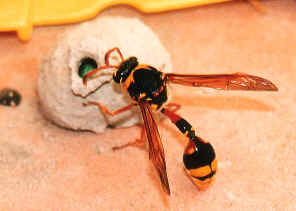
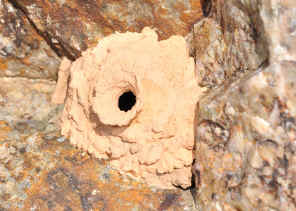
- Delta campaniforme, pot diameter 15mm, adult body length 22mm
- This Potter Wasps build mud nest with jug shape. They are solitary wasps. They are common around Brisbane. The wasps are dark brown in colour, with yellow banded abdomen. There is yellow pattern on their thorax. Their narrow waist is very long at the middle of their body. More information and pictures please click here.
- Brown Potter Wasp
-
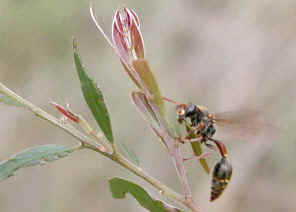

- Delta sp., body length 18mm
- The Brown Potter Wasp found a prey. It was a small caterpillar hiding in its shelter. The shelter was built by silk binding leaves together. The caterpillar seemed quite safe inside. However, after the wasp confirmed there was a caterpillar inside, the wasp cut open a small hole and stung the caterpillar. Then the wasp cut the leaves and got the caterpillar back to its 'Pot' as the food of her offspring. Details please check this page.
Genus Eumenes
- Orange Potter Wasp


- Eumenes latreilli, body length 20mm
- On early summer we saw this red-orange Potter Wasp picking up mud from the loose soil ground. We believed this wasp was collecting soils to build pot nest for its young. The wasp was bright orange red in colour with contrast black marking warning colour. There are more pictures and information in this page.
Genus Abispa
- Genus Abispa contains the largest Australian wasp species. They build large nest with globular structure with temporary trumpet-shaped entry.
- Large Mud-nesting Wasp I
-



- Abispa ephippium, body length 30mm
- This wasp is very large and with strong body. Its head, antenna and legs are orange-yellow. Its thorax is black with orange-yellow triangle shoulder. Its abdomen is segmented with orange-yellow and black. Large Potter Wasps are common in Brisbane. We often see them searching for caterpillars on leaves in gardens and bushes. They are solitary wasps and build mud pot-shaped nests in sheltered area. We had kept the nest and saw a wasp came out. More pictures and information please visit this page.
- Large Mud-nesting Wasp II
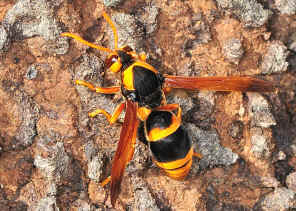


- Abispa splendida, body length 25mm
- This wasp is large and with strong body. Its head, antenna and legs are yellow in colour. Its thorax is black with yellow triangle shoulder. Its abdomen is segmented with yellow and black. This species is slightly smaller than the above Large Mud-nesting Wasp species that we found. nore information can be found in this page.
- Black-headed Mud-nesting Wasp


- ? Pseudabispa or Epiodynerus sp, body length 15mm
- This orange colour Mud-nest Wasp was collecting mud on a footpath. The pictures were take in Karawatha Forest during mid summer. The wasp look similar to the species above but smaller in size. The wings and abdomen colours were different, head is black in colour. Please check this page for more infromation.
Genus Paralastor
- Paralastor sp. in which the 2nd submarginal cell of the fore wing is petiolate.
- Black Mud-nesting Wasp I


- Paralastor sp., body length 20mm
- Pictures were taken on Jan 2010 in Carbrook Wetland. The wasp was checking a massy spider nest. Please check this page for more infromation.
- Black Mud-nesting Wasp II

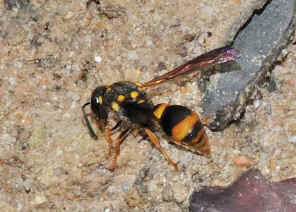
- Paralastor sp., body length 15mm
- We also saw this one collecting mud in Karawatha Forest on Jan 2010. Please check this page for more information.
- Fire-tailed Mud-nesting Wasp 1


- ? Anterhynchium sp., body length 20mm
- We first saw this wasp in Karawatha Forest during mid summer. It was collecting mud from loose soil. Please check this page for more information.
- Fire-tailed Mud-nesting Wasp 2


- ? Bidentodynerus sp, body length 20mm
- This wasp has the dark head and thorax. Its abdomen is bright orange in colour. It looked very similar to the wasp about but its shoulder, wing leading edge and legs are all bright orange in colour. Please check this page for more information.
- Fire-tailed Mud-nesting Wasp 3
-

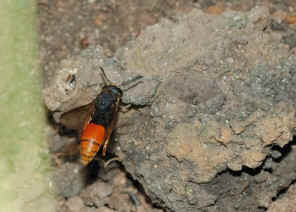
- ? Pseudabispa sp, body length 20mm
- We quite often saw this wasp collection mud on sandy soil. Please check this page for more information.
- Brown Mason Wasp


- ? Euodynerus sp, body length 20mm
- We found this wasp collecting mud in Karawatha Forest on Oct 2007. Please check this page for more information.
- Black Mason Wasp


- ? Rhynchium sp, body length 20mm,
- This wasp was found resting on grass stem just before sunset. Potter Wasps rest on grass stem after sunset. Please check this page for more information.
- Reference:
- 1. Insects of Australia, CSIRO, Division of Entomology, Melbourne University Press, 2nd Edition 1991, pp 979.
- 2. Insects of Australia and New Zealand - R. J. Tillyard, Angus & Robertson, Ltd, Sydney, 1926, p295.
- 3. What wasp is that? - An interactive identification guide to the Australasian families of Hymenoptera, 2007.
- 4. Northern Territory Insects, A Comprehensive Guide CD - Graham Brown, 2009.
- 5. Subfamily Eumeninae - Australian Faunal Directory, Australian Biological Resources Study.
- 6. Eumeninae {subfamily} - Arthropoda; Insecta; Hymenoptera; Vespidae - BOLDSYSTEMS.
- 7. Eumeninae, Vespidae - Graeme's Insects of Townsville, Australia.
- 8. Tropical Ecology Research Facility - by Cor Zonneveld, Natural History Photographs.
